 W
WCoffee culture is the set of traditions and social behaviors that surround the consumption of coffee, particularly as a social lubricant. The term also refers to the cultural diffusion and adoption of coffee as a widely consumed stimulant. In the late 20th century, espresso became an increasingly dominant drink contributing to coffee culture, particularly in the Western world and other urbanized centers around the globe.
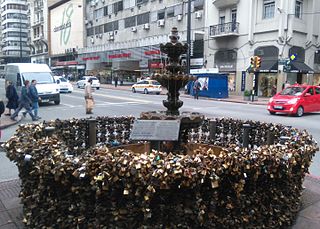 W
WBar Facal is one of the most traditional Uruguayan coffeehouse. Located in the corner 18 de Julio avenue and Yí street, Centro, Montevideo, Uruguay. It was founded in 1882 by Galician Manuel Facal and his brothers. It is the oldest Uruguayan downtown bar.
 W
WA barista is a person, usually a coffeehouse employee, who prepares and serves espresso-based coffee drinks.
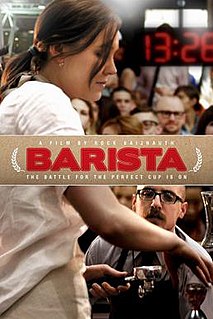 W
WBarista is a 2015 American documentary film directed by Rock Baijnauth. The film follows five baristas, as they prepare for the 2013 United States Barista Championship. Viewers are introduced into the elevation of the everyday drink, into a craft culture not unlike that of beer and wine. The film was acquired for distribution by Samuel Goldwyn Films.
 W
WA bikini barista is a woman who prepares and serves caffeinated beverages while dressed in scanty attire such as a bikini, lingerie, or cropped tops and bikini bottoms or hotpants. In the United States, this marketing trend originated in the Seattle, Washington area in the early 2000s. Similar phenomena have appeared in countries such as Chile and Japan since at least the 1980s.
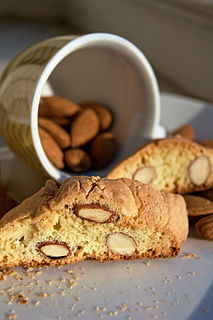 W
WBiscotti, known also as cantucci, are Italian almond biscuits that originated in the Tuscan city of Prato. They are twice-baked, oblong-shaped, dry, crunchy, and may be dipped in a drink, traditionally Vin Santo.
 W
WBlack Coffee is a 2007 three-part documentary series directed by Irene Lilienheim Angelico examining the complicated history of coffee and detailing its political, social, and economic influence from the past to the present day.
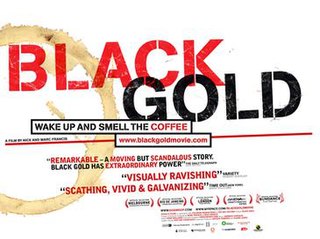 W
WBlack Gold is a 2006 documentary film that follows the efforts of an Ethiopian coffee-union manager as he travels the world to obtain a better price for his workers' coffee beans. The film was directed and produced by Marc James Francis and Nick Francis from Speakit Films, and co-produced by Christopher Hird. It premiered at the 2006 Sundance Film Festival.
 W
WThe Black Russian is a cocktail of vodka and coffee liqueur. It contains two parts vodka to one part coffee liqueur, per IBA specified ingredients. Traditionally, the drink is made by pouring the vodka over ice cubes or cracked ice in an old-fashioned glass, followed by the coffee liqueur.
 W
WBrewed coffee is made by pouring hot water onto ground coffee beans, then allowing to brew. There are several methods for doing this, including using a filter, a percolator, and a French press. Terms used for the resulting coffee often reflect the method used, such as drip brewed coffee, filtered coffee, pour-over coffee, immersion brewed coffee, or simply coffee. Water seeps through the ground coffee, absorbing its constituent chemical compounds, and then passes through a filter. The used coffee grounds are retained in the filter, while the brewed coffee is collected in a vessel such as a carafe or pot.
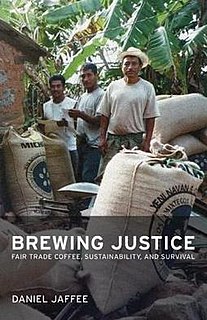 W
WBrewing Justice: Fair Trade Coffee, Sustainability and Survival is a book by American academic Daniel Jaffee.
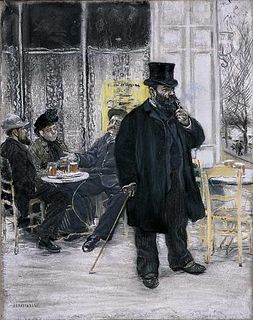 W
WCafé Guerbois, on Avenue de Clichy in Paris, was the site of late 19th-century discussions and planning amongst artists, writers and art lovers – the bohèmes (bohemians), in contrast to the bourgeois.
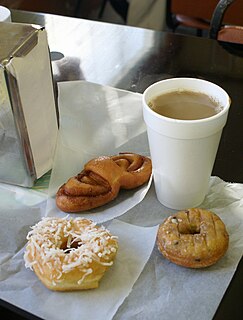 W
WCoffee and doughnuts is a common food and drink pairing in the United States and Canada. The pairing is often consumed as a simple breakfast, and is often consumed in doughnut shops. Coffee is a brewed drink that is typically served hot. Doughnuts are sweet, deep fried desserts. The pairing may also be served and consumed as a refreshment.
 W
WA coffee ceremony is a ritualized form of making and drinking coffee. The coffee ceremony was first practiced by the southwestern Ethiopian people. There is a routine of serving coffee daily, mainly for the purpose of getting together with relatives, neighbors, or other visitors. If coffee is politely declined, then tea will most likely be served.
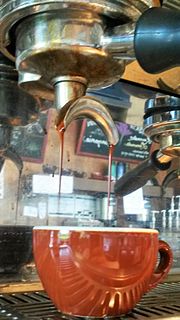 W
WA coffee cup is a container that coffee and espresso-based drinks are served in. Coffee cups are typically made of glazed ceramic, and have a single handle for portability while the beverage is hot. Ceramic construction allows a beverage to be drunk while hot, providing insulation to the beverage, and quickly washed with cold water without fear of breakage, compared to typical glassware.
 W
WCoffee cup sleeves, also known as coffee sleeves, coffee clutches, coffee cozies, hot cup jackets, paper zarfs, coffee collars, coffee sleeve, and cup holders, are roughly cylindrical sleeves that fit tightly over handle-less paper coffee cups to insulate the drinker's hands from hot coffee. Coffee sleeves are typically made of textured paperboard, but can be found made of other materials. Coffee sleeves allow coffee houses, fast food restaurants, and other vendors to avoid double-cupping, the practice of using two nested paper cups for a single hot beverage. Some paper cup holders carry advertisements.
 W
WA coffee palace was an often large and elaborate residential hotel that did not serve alcohol, most of which were built in Australia in the late 19th century.
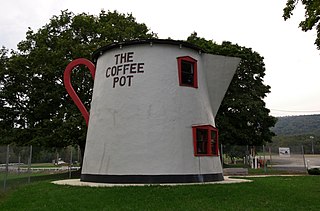 W
WThe Coffee Pot in Bedford, Pennsylvania is an example of novelty architecture. The lunch stand was built in the shape of a coffee pot by David Koontz in 1927. It was threatened with demolition in the 1990s, but in 2004 was moved across the street and restored. It currently serves as a gift shop.
 W
WThe Coffee Trader is a historical novel by David Liss, set in 17th-century Amsterdam. The story revolves around the activities of commodity trader Miguel Lienzo, who is a Jewish refugee from the Portuguese Inquisition. Recovering from near financial ruin, he embarks on a coffee trading scheme with a Dutch woman, kept secret because it is forbidden by his community council. Miguel navigates the social structures of the Amsterdam business world, the politics of the council, and the plots of competitors bringing this new import to Europe.
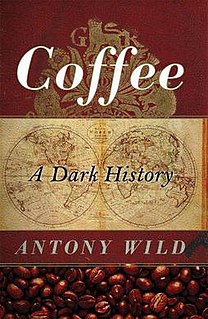 W
WCoffee: A Dark History is a 2005 book that examines the history of coffee. It was written by Antony Wild and was published by Norton. Wild had previously worked as a buyer for a specialty-coffee company for over ten years. He argues that coffee has had major effects on the economy of the British Empire. He also maintains that First World consumption of coffee and the accompanying free trade policies have had a negative impact on Third World coffee farmers.
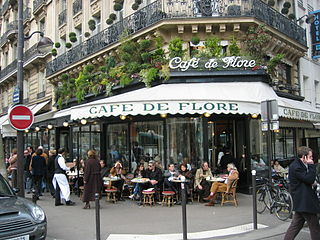 W
WA coffeehouse, coffee shop, or café is an establishment that primarily serves coffee. Some coffeehouses may serve cold drinks such as iced coffee and iced tea; in continental Europe, cafés serve alcoholic drinks. A coffeehouse may also serve food such as light snacks, sandwiches, muffins, fruit or pastries. Coffeehouses range from owner-operated small businesses to large multinational corporations. Some coffeehouse chains operate on a franchise business model, with numerous branches across various countries around the world.
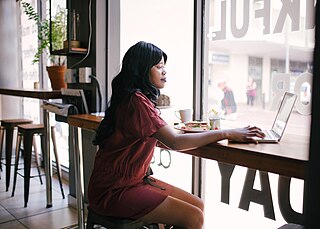 W
WThe Coffeehouse effect is a recent trend concerning people who go to coffeehouses to study or work productively. It is a recent phenomenon, born within the new century and widespread to workers and students. The main reasons of its birth are, on one hand, a more flexible work generation, characterized by the fact that workers don’t own an office anymore and they need a space to work. On the other hand, the phenomenon has developed due to the lack of studying spaces in universities, which have seen an increase among the enrolled students, who had to face this problem by looking for different spaces to study and meet for group-work: they found in coffeehouses a productive space to work for their projects and study.
 W
WParque del Café is a theme park in the department of Quindío, Colombia, 4 km south-west of the town of Montenegro and 11 km west of the departmental capital city Armenia. The park was founded by the National Federation of Coffee Growers of Colombia and the Departmental Committee of Coffee Growers of Quindío, and opened on 24 February 1995. It consists of two main areas: by the main entrance are the buildings housing the museum and exhibitions detailing the history, culture and process of growing and producing coffee in the region; and in the valley beyond is an amusement park with rides and shows. The two areas are linked by two gondola lifts and a chairlift: it is also possible to walk between the two areas via an ecological trail that passes through a plantation of many varieties of coffee bushes.
 W
WA demitasse spoon is a diminutive spoon, smaller than a teaspoon.
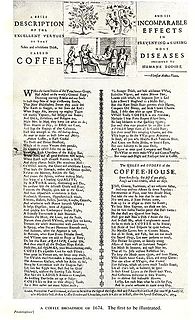 W
WEnglish coffeehouses in the 17th and 18th centuries were public social places where men would meet for conversation and commerce. For the price of a penny, customers purchased a cup of coffee and admission. Travellers introduced coffee as a beverage to England during the mid-17th century; previously it had been consumed mainly for its supposed medicinal properties. Coffeehouses also served tea and hot chocolate as well as a light meal.
 W
WEspresso is a coffee-brewing method of Italian origin, in which a small amount of nearly boiling water is forced under 9–10 bars of pressure (expressed) through finely-ground coffee beans. Espresso coffee can be made with a wide variety of coffee beans and roast degrees. Espresso is the most common way of making coffee in southern Europe, especially in Italy, Spain, Portugal, Switzerland, Southern France and Bulgaria.
 W
WGreek café culture in Australia is part of the shared history of Greece and Australia. For unskilled penniless Greek migrants, it was a pathway to success in which they created community hubs where Australians socialised. Greek cafés are also a singularly Australian phenomenon: the success of Arthur Comino’s fish shop in Sydney gave rise to a chain migration that saw hundreds of Greek migrants open oyster saloons across the country by 1900. Adapting to market changes and food trends, Greek proprietors went on to run fish shops, fruit shops, ice cream parlours, sundae shops, milk bars, snack bars, confectioneries, and cafés that dotted the Australian landscape for much of the twentieth century.
 W
WHabesha kemis is the traditional attire of Habesha women.
 W
WInternational Coffee Day is an occasion that is used to promote and celebrate coffee as a beverage, with events now occurring in places across the world. The first official date was 1 October 2015, as agreed by then International Coffee Organization and was launched in Milan. This day is also used to promote fair trade coffee and to raise awareness for the plight of the coffee growers. On this day, many businesses offer free or discounted cups of coffee. Some businesses share coupons and special deals with their loyal followers via social networking. Some greeting card companies sell National Coffee Day greeting cards as well as free e-cards.
 W
WAn Internet café is a café that provides Internet access to the public. The fee for using a computer is generally charged as a time-based rate.
 W
WKafana / kavana / kahvana ; kafene\kafeneja, kafeana, kavarna ; are terms used in most former Yugoslav countries and Albania for a distinct type of local bistro which primarily serves alcoholic beverages and coffee, and often also light snacks (meze) and other food. Many kafanas feature live music performances.
 W
WLatte art is a method of preparing coffee created by pouring microfoam into a shot of espresso and resulting in a pattern or design on the surface of the latte. It can also be created or embellished by simply "drawing" in the top layer of foam. Latte art is particularly difficult to create consistently, due to the demanding conditions required of both the espresso shot and milk. This, in turn, is limited by the experience of the barista and quality of the espresso machine. The pour itself, then, becomes the last challenge for the latte artist. The term is not limited to latte coffee but also applies to other beverages containing milk foam, such as cappuccino and hot chocolate.
 W
WA mug is a type of cup typically used for drinking hot drinks, such as coffee, hot chocolate, or tea. Mugs usually have handles and hold a larger amount of fluid than other types of cup. Typically, a mug holds approximately 8–12 US fluid ounces (240–350 ml) of liquid. A mug is a less formal style of drink container and is not usually used in formal place settings, where a teacup or coffee cup is preferred. Shaving mugs are used to assist in wet shaving.
 W
WSchweigt stille, plaudert nicht, BWV 211, also known as the Coffee Cantata, is a secular cantata by Johann Sebastian Bach. He composed it probably between 1732 and 1735. Although classified as a cantata, it is essentially a miniature comic opera. In a satirical commentary, the cantata amusingly tells of an addiction to coffee.
 W
WSeattle is regarded as a world center for coffee roasting and coffee supply chain management. Related to this, many of the city's inhabitants are coffee enthusiasts; the city is known for its prominent coffee culture and numerous coffeehouses.
 W
WSelva Negra Mountain Resort and Coffee Estate is a historical coffee farm founded in 1891 by German immigrants. Since 1976 it has also been a tourist resort. It is located in the department of Matagalpa, Nicaragua, just 11 kilometres (7 mi) from the city of Matagalpa. According to Fodor's, Selva Negra is "arguably Nicaragua's most famous hotel," and proprietor Eddy Kühl is "a personal friend of many of the country's power brokers."
 W
WThe third wave coffee movement is a movement led by both consumers and manufacturers to consume, enjoy, and appreciate high-quality coffee. This movement considers coffee an artisanal food, like wine, whose consumption experience can be enhanced with greater education, connoisseurship, and sensory exploration beyond just a cup of coffee. While all coffee comes through a similar value stream, third wave coffee seeks to highlight the unique characteristics that result from the diversity of coffee bean cultivars, growing and cultivation methods, processing methods, roasting methods, and the variables in beverage preparation.
 W
WTufahije is a Bosnian dessert made of walnut-stuffed apples poached in sugar water. It is very popular in Bosnia and Herzegovina, Serbia, North Macedonia and Croatia.
 W
WTurkish coffee is a style of coffee prepared using very finely ground coffee beans without filtering.
 W
WA White Russian is a cocktail made with vodka, coffee liqueur and cream served with ice in an Old Fashioned glass. Often milk, half and half, or cream liqueur will be used as an alternative to cream.